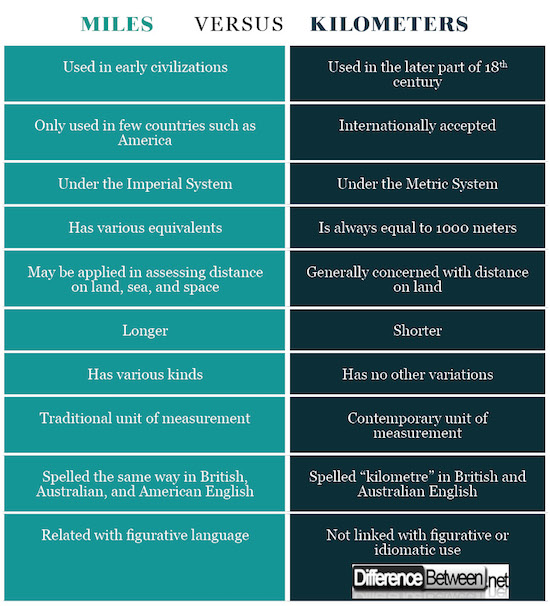Difference Between Miles and Kilometers
Miles and kilometers are units of distance and both words literally mean “thousand” from their respective origins. The former is under the Imperial system which is only utilized in the United States, Liberia, and Burma while the latter is a part of the metric system which is the adopted standard in the rest of the world. Though the use of miles originated from the British Empire, the United Kingdom has adopted the use of kilometers in 1965 through a government policy to support metrication. Still, numerous locations in the UK use miles in their road signs.

What is Miles?
Mile came from the Latin word, “milia” which translates to “thousand”. In ancient Rome, one mile is a thousand paces. This gave rise to “milestones” which are shaped stones where Roman numerals are carved. These figures indicated the distance from the center of the empire. Eventually, this kind of measurement spread to various territories such as Italy, Arabia, Ireland, Germany, and Portugal.
Miles, which is abbreviated as “m” or “mi” is under the Imperial System or Exchequer Standards. This system of units was officially used in the British Empire in 1824 and was implemented by various countries since. One mile is equal to 1609.34 meters or 1.60934 kilometers.
Miles is employed in various aspects of measurements:
-
International Mile
This is the most popular understanding of mile. Specifically, 1 international mile is 1.61 km which was recognized in the 1959 International Yard and Pound Agreement among the US, UK, Canada, South Africa, New Zealand, and Australia.
-
US Survey Mile
One international mile is 0.99 US survey miles; hence, the difference between the two is generaly insignificant.
-
Nautical Mile
Originally, the nautical mile was demarcated as a minute of arc along the Earth’s meridian. In the 19th century 1 nautical mile was 6,080 feet in the US while it was slightly longer at 6,080.2 feet in the UK. Currently, the international equivalent is 6,076.12 feet.
-
Metric Mile
This is an informal term which is utilized in track and field, speed skating, and other related sports. One metric mile is largely understood in athletics as 1,500 meters though it is sometimes 1,600 meters in US high-school athletics.
-
Scandinavian Mile (mil)
Largely applied in Sweden and Norway, the Scandinavian mile is equal to around 10 kilometers.

What is Kilometers?
Kilometers or “km” is a part of the metric system or International System of Units (SI). As it name suggests, 1 km is equal to 1000 meters as the prefix “kilo”- literally means 1,000 in Greek. It is the official unit in measuring geographical distances in most parts of the globe. The International Committee for Weights and Measurements (CICPM) was instrumental in recognizing the kilometer as a world-wide standard unit of length measurement during the unification processes in the 19th century.
Difference between Miles and Kilometers
History of Miles and Kilometers
In history, miles as a unit was used by ancient civilizations. On the other hand, kilometers only came into utility in the 1790s.
Acceptance of Miles and Kilometers
Kilometers is widely accepted worldwide as it is under the International System of Units while miles as a unit is only being used in a few territories.
System of Miles and Kilometers
Miles is under the Imperial System whereas kilometers is under the Metric System.
Consistency in Conversion of Miles and Kilometers
One kilometer is always 1000 meters while 1 mile can have various equivalents. For instance, 1 international mile is 1,609.34 meters while 1 US survey mile is 1,609.35.
Application of Miles and Kilometers
Generally, kilometers as a unit is used for length or distance on land while miles may also be associated with nautical and maritime navigation.
Length
A mile is longer than a kilometer since 1 mile is equal to 1.61 kilometers.
Variation
Miles has more kinds such as nautical, US survey, Scandinavian, metric, and international while kilometers is plainly understood as is.
Being current
Miles is more of a traditional unit of measurement as has its foundations from Roman legions and early Tudor rulers. On the contrary, kilometers as a unit was realized with the recognition of the metric system in the 18th to 19th century.
British and American Spelling
Mile is spelled the same way in both British and American English. On the other hand, “kilometer” is the British as well as Australian English spelling.
Figurative Use of Miles and Kilometers
“Mileage” is literally meant as the number of miles traveled. Figuratively, it is the allowance for travel costs. It is also an idiom for advantage or profit of something. However, “kilometrage” is only meant for the distance covered and some dictionaries have not yet incorporated the term into their systems.
Miles vs Kilometers : Comparison Chart

Summary of Miles vs. Kilometers
- Both miles and kilometers are used as measurement units of distance.
- Both terms literally mean “thousand”.
- Miles was used in the early civilizations in Europe while kilometers was only introduced in the 18th century. Thus, “miles” is a traditional unit of measurement.
- Only a few countries utilize miles while most countries use kilometers.
- Miles is under the Imperial System while kilometers is under the metric system.
- Miles has differing equivalents. Hence, it is less consistent.
- Kilometers is generally confined to distances on land while miles can be used in nautical and maritime navigation.
- Miles is longer as it is equal to 1.61 kilometers.
- Miles is spelled the same way in the different English speaking countries while it is spelled as “kilometer” in British and Australian English.
- Miles is linked with figurative use while kilometers is not.
- Difference Between Hematoma and Melanoma - February 9, 2023
- Difference Between Bruising and Necrosis - February 8, 2023
- Difference Between Brain Hematoma and Brain Hemorrhage - February 8, 2023
Search DifferenceBetween.net :
1 Comment
Leave a Response
References :
[0]Morris, Alan, and Langari, Reza. Measurement and Instrumentation. Massachusetts: Academic Press, 2015. Print.
[1]Marciano, John. Whatever Happened to the Metric System? New York: Bloomsbury, 2015. Print.
[2]Davies, Charles. The Metric System. South Carolina: Nabu Press, 2010. Print.
[3]Image credit: https://pixabay.com/en/road-driving-speed-35-miles-per-44115/
[4]Image credit: https://pixabay.com/en/speed-limit-sign-60-km-909988/

The article would be a little more credible if it did not have 3 separate definitions of the relation between International and U.S. Survey miles. All three being incompatible.